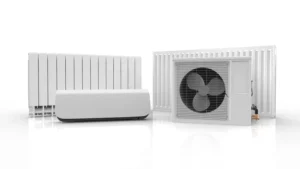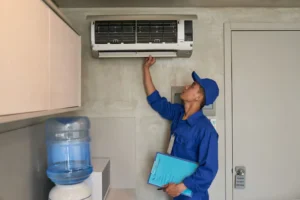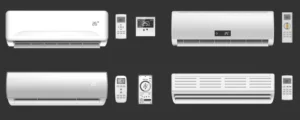Choosing Between Split and Window AC for Energy Efficiency
Learn how to choose between a Split and Window AC for energy efficiency. Discover the Best Energy Efficient AC and make an informed decision for your space. Regular air condition repair is essential to maintaining your AC’s efficiency and ensuring it runs smoothly for years to come.
When it comes to staying cool during scorching summers, selecting the right air conditioning system for your home or office is crucial. Not only does this decision impact your comfort, but it also plays a significant role in energy consumption and your utility bills. The two most common types of ACs—split and window units—each come with their own set of advantages and disadvantages. In this guide, we’ll compare both types based on their energy efficiency and help you determine which one is the best for you.

Understanding Energy Efficiency in AC Units
Before diving into the specifics of split vs. window AC units, let’s first understand the concept of energy efficiency in air conditioning. An energy-efficient AC unit is one that uses the least amount of electricity while still providing the necessary cooling. This not only helps you save money on your energy bills but also reduces your carbon footprint.
When looking for the Best Energy Efficient AC, you’ll want to consider the unit’s Energy Efficiency Ratio (EER) or Seasonal Energy Efficiency Ratio (SEER). Higher ratings indicate better energy efficiency.
Window AC: A Traditional Cooling Option
Window air conditioners have been around for decades and are still one of the most popular choices for many households. They are installed directly into a window and are typically smaller in size than split units. Here are the key pros and cons of a window AC in terms of energy efficiency:
Pros:
- Lower Initial Cost: Window AC units generally have a lower purchase and installation cost compared to split AC systems.
- Space-Saving: Since they are installed in the window, they do not take up any floor or wall space, making them ideal for small rooms.
- Quick Installation: The installation process is generally quicker and more straightforward than that of a split unit.
Cons:
- Noise Level: Window units tend to be noisier as both the compressor and the fan are located in the same unit.
- Limited Cooling Power: Window units are ideal for smaller rooms. They may not be able to cool larger spaces as efficiently as a split unit.
- Lower Energy Efficiency: While modern window ACs are more energy-efficient than older models, they still lag behind split systems in terms of SEER and EER ratings.
Split AC: A More Advanced and Energy-Efficient Option
Split air conditioners have become increasingly popular over the years due to their quiet operation and superior cooling performance. Split systems consist of two main components: an indoor unit (evaporator) and an outdoor unit (compressor). Here’s a look at the pros and cons of split AC systems:
Pros:
- Better Cooling Efficiency: Split AC units are generally more energy-efficient than window units. They come with higher SEER and EER ratings, which means they use less electricity to provide the same level of cooling.
- Quieter Operation: Since the compressor is located outside, the indoor unit is much quieter compared to window units.
- Aesthetic Appeal: Split units are more aesthetically pleasing and can be installed in a way that doesn’t obstruct windows or disrupt the room’s design.
- Cooling Larger Spaces: Split ACs are more suited for larger rooms or multiple rooms, providing a more uniform cooling experience.
Cons:
- Higher Initial Cost: The initial cost of purchasing and installing a split AC system is higher compared to a window unit.
- Installation Complexity: Installation is more involved as it requires drilling holes in the wall for the pipes and wiring, which can be a hassle in some cases.
- Requires More Space: Although the indoor unit is compact, the outdoor compressor unit requires ample space outside the building.

Comparing Energy Efficiency: Which is Better for You?
When deciding between a Best Energy Efficient AC like a split unit or a window model, it’s important to consider the following factors:
1. Room Size and Cooling Requirements
- Window AC: Ideal for small to medium-sized rooms.
- Split AC: Best suited for larger rooms or spaces with multiple rooms that need cooling.
2. Energy Consumption
- Window AC: While window units have improved in terms of energy efficiency, they still consume more power compared to split units with the same cooling capacity.
- Split AC: Split units offer superior energy savings, especially models with high SEER ratings, making them the Best Energy Efficient AC choice for those who are looking to save on their energy bills.
3. Noise Levels
- Window AC: Produces more noise, which may be disturbing in bedrooms or quiet spaces.
- Split AC: Quieter operation, especially useful in spaces where silence is preferred.
4. Budget and Installation
- Window AC: If you’re on a tight budget or need a quick installation, a window AC could be your best option. However, keep in mind that it may lead to higher electricity costs in the long run.
- Split AC: The higher upfront cost of split AC units can be justified by the long-term savings on energy bills, as they offer more efficient cooling.
Best Energy Efficient AC: Key Features to Look For
When shopping for the Best Energy Efficient AC, regardless of whether you opt for a split or window unit, there are a few key features to look out for:
- High SEER Rating: The SEER rating is a key indicator of an AC’s energy efficiency. Look for units with a SEER of 15 or higher for optimal savings.
- Inverter Technology: Inverter ACs adjust the compressor speed based on the room’s temperature, making them more energy-efficient than traditional models.
- Eco-Friendly Refrigerant: Look for ACs that use eco-friendly refrigerants such as R-32, which have a lower global warming potential than older types like R-22.

FAQs About Choosing Between Split and Window ACs
Q1: Which type of AC is more energy-efficient?
A: Split ACs are generally more energy-efficient than window units, especially if they come with inverter technology and a high SEER rating.
Q2: Can I use a window AC for a large room?
A: Window ACs are better suited for small to medium-sized rooms. For larger spaces, a split AC is usually more effective in terms of both cooling and energy efficiency.
Q3: How can I make my AC more energy-efficient?
A: Regular maintenance, such as cleaning filters and ensuring proper insulation, can improve your AC’s efficiency. Additionally, using a programmable thermostat and setting your AC to a higher temperature when not at home can help reduce energy consumption.
Making the Right Choice for Energy Efficiency
Choosing the Best Energy Efficient AC depends on your specific needs, room size, budget, and long-term energy savings. While window ACs are cost-effective and easy to install, split ACs offer superior efficiency, quieter operation, and better cooling for larger spaces. To maintain optimal performance, consider investing in Best air condition repair services in Kolkata, which can ensure your AC runs efficiently throughout its lifespan. By considering these factors, you can make an informed decision that will keep your space cool and comfortable without increasing your electricity bills.
When you choose the right AC for your home or office, you not only ensure optimal comfort but also contribute to saving energy and reducing environmental impact. Whether you opt for a split or window AC, make sure you schedule regular maintenance to keep your system running at its best.



